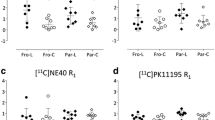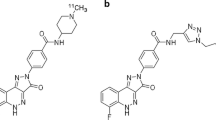Abstract
Purpose
The ligand [11C]PK11195 binds with high affinity and selectivity to peripheral benzodiazepine receptor, expressed in high amounts in macrophages. In humans, [11C]PK11195 has been used successfully for the in vivo imaging of inflammatory processes of brain tissue. The purpose of this study was to explore the feasibility of [11C]PK11195 in imaging inflammation in the atherosclerotic plaques.
Methods
The presence of PK11195 binding sites in the atherosclerotic plaques was verified by examining the in vitro binding of [3H]PK11195 onto mouse aortic sections. Uptake of intravenously administered [11C]PK11195 was studied ex vivo in excised tissue samples and aortic sections of a LDLR/ApoB48 atherosclerotic mice. Accumulation of the tracer was compared between the atherosclerotic plaques and non-atherosclerotic arterial sites by autoradiography and histological analyses.
Results
The [3H]PK11195 was found to bind to both the atherosclerotic plaques and the healthy wall. The autoradiography analysis revealed that the uptake of [11C]PK11195 to inflamed regions in plaques was more prominent (p = 0.011) than to non-inflamed plaque regions, but overall it was not higher than the uptake to the healthy vessel wall. Also, the accumulation of 11C radioactivity into the aorta of the atherosclerotic mice was not increased compared to the healthy control mice.
Conclusions
Our results indicate that the uptake of [11C]PK11195 is higher in inflamed atherosclerotic plaques containing a large number of inflammatory cells than in the non-inflamed plaques. However, the tracer uptake to other structures of the artery wall was also prominent and may limit the use of [11C]PK11195 in clinical imaging of atherosclerotic plaques.




Similar content being viewed by others
References
Jander S, Sitzer M, Schumann R, Schroeter M, Siebler M, Steinmetz H, et al. Inflammation in high-grade carotid stenosis: a possible role for macrophages and T cells in plaque destabilization. Stroke 1998;29:1625–30.
Moreno PR, Bernardi VH, Lopez-Cuellar J, Murcia AM, Palacios IF, Gold HK, et al. Macrophages, smooth muscle cells, and tissue factor in unstable angina. Implications for cell-mediated thrombogenicity in acute coronary syndromes. Circulation 1996;94:3090–7.
Naghavi M, Libby P, Falk E, Casscells SW, Litovsky S, Rumberger J, et al. From vulnerable plaque to vulnerable patient: a call for new definitions and risk assessment strategies: part I. Circulation 2003;108:1664–72.
Laitinen I, Marjamäki P, Haaparanta M, Savisto N, Laine VJ, Soini SL, et al. Non-specific binding of [18F]FDG to calcifications in atherosclerotic plaques: experimental study of mouse and human arteries. Eur J Nucl Med Mol Imaging 2006;33:1461–7.
Ogawa M, Ishino S, Mukai T, Asano D, Teramoto N, Watabe H, et al. [18F]-FDG accumulation in atherosclerotic plaques: immunohistochemical and PET imaging study. J Nucl Med 2004;45:1245–50.
Rudd JH, Warburton EA, Fryer TD, Jones HA, Clark JC, Antoun N, et al. Imaging atherosclerotic plaque inflammation with [18F]-fluorodeoxyglucose positron emission tomography. Circulation 2002;105:2708–11.
Tawakol A, Migrino RQ, Hoffmann U, Abbara S, Houser S, Gewirtz H, et al. Noninvasive in vivo measurement of vascular inflammation with F-18 fluorodeoxyglucose positron emission tomography. J Nucl Cardiol 2005;12:294–301.
Papadopoulos V, Baraldi M, Guilarte TR, Knudsen TB, Lacapere JJ, Lindemann P, et al. Translocator protein (18kDa): new nomenclature for the peripheral-type benzodiazepine receptor based on its structure and molecular function. Trends Pharmacol Sci 2006;27:402–9.
Le Fur G, Guilloux F, Rufat P, Benavides J, Uzan A, Renault C, et al. Peripheral benzodiazepine binding sites: effect of PK 11195, 1-(2-chlorophenyl)-N-methyl-(1-methylpropyl)-3 isoquinolinecarboxamide. II. In vivo studies. Life Sci 1983;32:1849–56.
Canat X, Carayon P, Bouaboula M, Cahard D, Shire D, Roque C, et al. Distribution profile and properties of peripheral-type benzodiazepine receptors on human hemopoietic cells. Life Sci 1993;52:107–18.
Zavala F, Haumont J, Lenfant M. Interaction of benzodiazepines with mouse macrophages. Eur J Pharmacol 1984;106:561–6.
Anholt RR, De Souza EB, Oster-Granite ML, Snyder SH. Peripheral-type benzodiazepine receptors: autoradiographic localization in whole-body sections of neonatal rats. J Pharmacol Exp Ther 1985;233:517–26.
Parola AL, Yamamura HI, Laird HE III. Peripheral-type benzodiazepine receptors. Life Sci 1993;52:1329–42.
Veenman L, Gavish M. The peripheral-type benzodiazepine receptor and the cardiovascular system. Implications for drug development. Pharmacol Ther 2006;110:503–24.
Hardwick MJ, Chen MK, Baidoo K, Pomper MG, Guilarte TR. In vivo imaging of peripheral benzodiazepine receptors in mouse lungs: a biomarker of inflammation. Mol Imaging 2005;4:432–8.
Jones HA, Valind SO, Clark IC, Bolden GE, Krausz T, Schofield JB, et al. Kinetics of lung macrophages monitored in vivo following particulate challenge in rabbits. Toxicol Appl Pharmacol 2002;183:46–54.
Jones HA, Marino PS, Shakur BH, Morrell NW. In vivo assessment of lung inflammatory cell activity in patients with COPD and asthma. Eur Respir J 2003;21:567–73.
Heinonen SE, Leppänen P, Kholova I, Lumivuori H, Häkkinen SK, Bosch F, et al. Increased atherosclerotic lesion calcification in a novel mouse model combining insulin resistance, hyperglycemia, and hypercholesterolemia. Circ Res 2007;101:1058–67.
Leppänen P, Koota S, Kholova I, Koponen J, Fieber C, Eriksson U, et al. Gene transfers of vascular endothelial growth factor-A, vascular endothelial growth factor-B, vascular endothelial growth factor-C, and vascular endothelial growth factor-D have no effects on atherosclerosis in hypercholesterolemic low-density lipoprotein-receptor/apolipoprotein B48-deficient mice. Circulation 2005;112:1347–52.
Veniant MM, Pierotti V, Newland D, Cham CM, Sanan DA, Walzem RL, et al. Susceptibility to atherosclerosis in mice expressing exclusively apolipoprotein B48 or apolipoprotein B100. J Clin Invest 1997;100:180–8.
Debruyne JC, Versijpt J, Van Laere KJ, De Vos F, Keppens J, Strijckmans K, et al. PET visualization of microglia in multiple sclerosis patients using [11C]PK11195. Eur J Neurol 2003;10:257–64.
Stary HC, Chandler AB, Dinsmore RE, Fuster V, Glagov S, Insull W Jr., et al. A definition of advanced types of atherosclerotic lesions and a histological classification of atherosclerosis. A report from the Committee on Vascular Lesions of the Council on Arteriosclerosis, American Heart Association. Circulation 1995;92:1355–74.
McEnery MW, Snowman AM, Trifiletti RR, Snyder SH. Isolation of the mitochondrial benzodiazepine receptor: association with the voltage-dependent anion channel and the adenine nucleotide carrier. Proc Natl Acad Sci U S A 1992;89:3170–4.
Zavala F, Lenfant M. Benzodiazepines and PK 11195 exert immunomodulating activities by binding on a specific receptor on macrophages. Ann N Y Acad Sci 1987;496:240–9.
Casellas P, Galiegue S, Basile AS. Peripheral benzodiazepine receptors and mitochondrial function. Neurochem Int 2002;40:475–86.
Branley HM, du Bois RM, Wells AU, Jones HA. Peripheral-type benzodiazepine receptors in bronchoalveolar lavage cells of patients with interstitial lung disease. Nucl Med Biol 2007;34:553–8.
Bazzichi L, Betti L, Giannaccini G, Rossi A, Lucacchini A. Peripheral-type benzodiazepine receptors in human mononuclear cells of patients affected by osteoarthritis, rheumatoid arthritis or psoriasic arthritis. Clin Biochem 2003;36:57–60.
De Vos F, Dumont F, Santens P, Slegers G, Dierckx R, De Reuck J. High-performance liquid chromatographic determination of [11C]1-(2-chlorophenyl)-N-methyl-N-(1-methylpropyl)-3-isoquinoline carboxamide in mouse plasma and tissue and in human plasma. J Chromatogr B Biomed Sci Appl 1999;736:61–6.
Virsu P, Laitinen I, Pöyhönen T, Någren K, Roivainen A. In vivo biodistribution, biokinetics and blood metabolism of [11C]PK11195 in rats—a PET tracer for peripheral benzodiatsepine receptor. Eur J Nucl Med Mol Imaging 2005;32:S266.
Aknowledgements
This work was funded by Ida Montin Foundation, Finnish Cultural Foundation, Turku University Foundation, Aarne Koskelo Foundation, Finnish Foundation for Cardiovascular Research and the Hospital District of Southwest Finland. The study is also partly supported by the Finnish Centre of Excellence in Molecular Imaging in Cardiovascular and Metabolic Research. The authors would like to thank adjunct professor Merja Haaparanta-Solin for revising the manuscript, Tarja Marttila and Marko Vehmanen for the technical assistance and M.Sc. Irina Lisinen for the statistical analysis.
Conflict of interest statement
The authors declare that they have no conflict of interest.
Author information
Authors and Affiliations
Corresponding author
Rights and permissions
About this article
Cite this article
Laitinen, I., Marjamäki, P., Någren, K. et al. Uptake of inflammatory cell marker [11C]PK11195 into mouse atherosclerotic plaques. Eur J Nucl Med Mol Imaging 36, 73–80 (2009). https://doi.org/10.1007/s00259-008-0919-6
Received:
Accepted:
Published:
Issue Date:
DOI: https://doi.org/10.1007/s00259-008-0919-6




